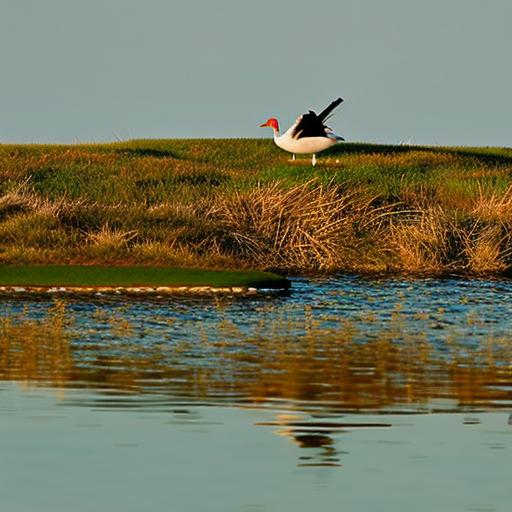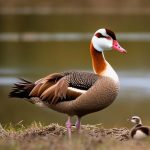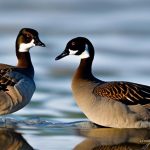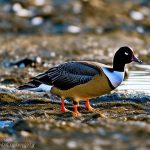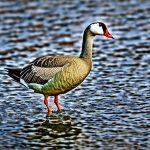Geese are a common sight on golf courses, and their presence can have both positive and negative impacts. While geese can add a touch of natural beauty to the landscape, their populations can quickly grow out of control, leading to various problems. It is important for golf course managers to understand the impact of geese on their courses and implement effective management strategies to maintain a healthy balance.
Managing geese populations is crucial for several reasons. First, an overabundance of geese can cause damage to the turf, leading to costly repairs and maintenance. Geese feed on grass, and their constant grazing can result in bare patches and uneven surfaces. Additionally, their droppings can create unsightly messes that are not only unpleasant for golfers but also pose health risks. Geese droppings contain high levels of bacteria, which can contaminate water sources and affect water quality. Lastly, geese can become aggressive during nesting season, posing safety concerns for golfers and staff.
Key Takeaways
- Geese can cause significant damage to golf courses, including turf destruction and water pollution.
- Natural and humane methods of geese deterrence include habitat modification and the use of decoys.
- Physical barriers and visual deterrents, such as fencing and scarecrows, can also be effective.
- Sound and motion devices, such as propane cannons and lasers, can help deter geese.
- Canine patrols can be a useful tool in geese control, but should be used in conjunction with other methods.
Understanding the Impact of Geese on Golf Courses
The negative effects of geese on golf courses are numerous and can have significant consequences for the overall health and aesthetics of the course. One of the most noticeable impacts is the damage caused to the turf. Geese are voracious grazers and can quickly strip large areas of grass, leaving behind bare patches that are unsightly and difficult to repair. This not only affects the appearance of the course but also affects playability, as golfers may encounter uneven surfaces or divots caused by geese.
Another concern is the impact on water quality. Geese droppings contain high levels of bacteria, including E. coli, which can contaminate water sources such as ponds or lakes on the golf course. This poses a risk to both humans and wildlife that come into contact with the water. In addition, the accumulation of droppings can lead to excessive nutrient runoff, which can contribute to algal blooms and other water quality issues.
Safety is also a significant concern when it comes to geese on golf courses. During nesting season, geese can become territorial and aggressive, especially if they feel threatened. Golfers and staff may encounter hissing or charging geese, which can lead to injuries. Additionally, the presence of geese droppings on walkways and greens can create slippery conditions, increasing the risk of slips and falls.
Natural and Humane Methods of Geese Deterrence
When it comes to managing geese populations on golf courses, it is important to prioritize natural and humane methods. These methods not only minimize harm to the geese but also promote a more sustainable approach to wildlife management. One effective strategy is habitat modification. By altering the landscape to make it less attractive to geese, golf course managers can discourage their presence. This can include planting tall grasses or shrubs around water sources, creating barriers that prevent access to certain areas, or implementing landscape designs that make it difficult for geese to graze.
Another natural and humane method is landscape management. By implementing proper turf care practices, such as regular mowing and aeration, golf course managers can create an environment that is less appealing to geese. Shorter grass makes it more difficult for geese to graze, while aeration helps improve soil health and drainage, reducing the attractiveness of the turf for feeding.
Physical Barriers and Visual Deterrents
In addition to natural and humane methods, physical barriers and visual deterrents can also be effective in deterring geese from golf courses. Physical barriers such as fencing or netting can be installed around water sources or sensitive areas to prevent geese from accessing them. This not only protects the turf but also reduces the risk of contamination from droppings.
Visual deterrents can also be used to discourage geese from settling on golf courses. Decoys, such as plastic coyotes or herding dogs, can create the illusion of a predator presence, causing geese to feel threatened and seek safer areas. Scarecrows or reflective tape can also be effective in deterring geese by creating visual disturbances that make them uncomfortable.
Implementing Sound and Motion Devices
Sound and motion devices can be another effective tool in geese control on golf courses. These devices work by creating auditory or visual disturbances that make geese uncomfortable and encourage them to seek quieter areas. Propane cannons, for example, emit loud noises at regular intervals, mimicking the sound of a gunshot and scaring geese away. Laser devices can also be used to create moving lights that disorient geese and make them feel unsafe.
It is important to note that sound and motion devices should be used responsibly and in compliance with local regulations. Excessive or continuous use of these devices can cause unnecessary stress to wildlife and may not be effective in the long term.
The Role of Canine Patrols in Geese Control

Canine patrols have proven to be highly effective in geese control on golf courses. Trained dogs can be used to patrol the course and deter geese from settling in unwanted areas. The presence of a dog creates a natural predator-prey dynamic, causing geese to feel threatened and seek safer locations. Canine patrols are not only effective but also provide a non-lethal and humane approach to geese management.
Canine patrols work by establishing a regular presence on the golf course, which creates a sense of territory for the dog and its handler. By consistently patrolling the area, the dog establishes itself as a deterrent, making it less likely for geese to settle in the vicinity. The mere scent or sight of a dog can be enough to discourage geese from landing or grazing on the course.
Utilizing Chemical Repellents and Taste Aversion
Chemical repellents can be used as a supplementary method in geese control on golf courses. One commonly used chemical repellent is Methyl Anthranilate, a grape extract that creates an unpleasant taste and smell for geese. When applied to turf or vegetation, Methyl Anthranilate deters geese from feeding, making the area less attractive to them.
Taste aversion is another method that can be used in conjunction with chemical repellents. This technique involves conditioning geese to associate the taste of certain plants or grasses with negative experiences. By applying a non-toxic but bitter-tasting substance to the turf, geese learn to avoid grazing in those areas. Over time, geese develop a taste aversion to the treated grass, reducing their impact on the golf course.
Collaborating with Wildlife Management Professionals
Managing geese populations on golf courses can be a complex task that requires expertise and knowledge of wildlife management. It is important for golf course managers to collaborate with wildlife management professionals who specialize in geese control. These professionals can provide guidance and assistance in developing effective and sustainable management strategies.
Working with wildlife management professionals offers several benefits. They have a deep understanding of geese behavior and biology, allowing them to develop targeted and customized management plans. They also have access to specialized tools and techniques that may not be readily available to golf course managers. Additionally, wildlife management professionals can provide ongoing monitoring and maintenance to ensure the long-term success of geese control efforts.
Importance of Regular Maintenance and Monitoring
Regular maintenance and monitoring are essential for effective geese management on golf courses. Geese are adaptable creatures and can quickly adjust their behavior in response to management efforts. Regular maintenance, such as mowing, aeration, and vegetation control, helps create an environment that is less attractive to geese. It also allows golf course managers to identify and address any issues or potential problem areas before they escalate.
Monitoring is equally important in geese management. By regularly assessing geese populations and their behavior, golf course managers can make informed decisions about the effectiveness of their management strategies. Monitoring can involve visual surveys, nest counts, or even remote sensing technologies to track geese movements and identify patterns. This information can then be used to adjust management plans and ensure long-term success.
Sustainable Practices for Long-Term Geese Management
To achieve long-term geese management on golf courses, it is important to adopt sustainable practices that promote a healthy balance between geese and the environment. One such practice is habitat restoration. By creating or restoring natural habitats that are attractive to geese, golf courses can provide alternative areas for feeding and nesting, reducing the pressure on the turf. This can include planting native vegetation, creating wetlands, or implementing wildlife-friendly landscaping practices.
Population control is another sustainable practice that can be implemented in geese management. This involves carefully managing the number of geese on the golf course through techniques such as egg addling or targeted culling. These methods aim to reduce the reproductive success of geese without causing harm to the individuals or the overall population. Population control should always be carried out in collaboration with wildlife management professionals to ensure ethical and effective outcomes.
Geese management on golf courses is a multifaceted task that requires careful planning and implementation. The negative impacts of geese on turf, water quality, and safety cannot be ignored, but it is important to prioritize natural and humane methods in managing their populations. By utilizing a combination of habitat modification, physical barriers, visual deterrents, sound and motion devices, canine patrols, chemical repellents, taste aversion, and collaborating with wildlife management professionals, golf course managers can achieve effective and sustainable geese control. Regular maintenance and monitoring, along with the adoption of sustainable practices, are crucial for long-term success. By taking a holistic approach to geese management, golf courses can maintain a healthy balance between geese and the environment, ensuring a pleasant and safe experience for golfers and wildlife alike.
If you’re interested in learning more about effective methods to keep geese away from golf courses, you might find this article on Poultry Wizard quite helpful. It discusses the benefits of having a garden chicken coop, such as the Producers Pride Sentinel Chicken Coop, which can be a great solution for deterring geese. Check out the article here: https://poultrywizard.com/keeping-chickens/garden-chicken-coop/. Additionally, if you’re looking for more options, you can also explore the Chicken Coop 10, another recommended coop that can assist in keeping geese away. Find out more about it here: https://poultrywizard.com/keeping-chickens/chicken-coop-10/.
FAQs
What are the common problems caused by geese in golf courses?
Geese can cause damage to the turf, create unsightly droppings, and pose a safety hazard to golfers.
What are the methods used by golf courses to keep geese away?
Golf courses use a variety of methods to keep geese away, including habitat modification, physical barriers, noise deterrents, and chemical repellents.
What is habitat modification?
Habitat modification involves altering the environment to make it less attractive to geese. This can include removing food sources, planting unpalatable vegetation, and creating barriers to nesting sites.
What are physical barriers?
Physical barriers are structures that prevent geese from accessing certain areas of the golf course. Examples include fences, netting, and floating barriers.
What are noise deterrents?
Noise deterrents are devices that emit loud, unpleasant sounds to scare geese away. Examples include propane cannons, air horns, and electronic devices that mimic the sound of predators.
What are chemical repellents?
Chemical repellents are substances that are applied to the turf or other surfaces to make them unpalatable to geese. Examples include methyl anthranilate and capsaicin.
Meet Walter, the feathered-friend fanatic of Florida! Nestled in the sunshine state, Walter struts through life with his feathered companions, clucking his way to happiness. With a coop that’s fancier than a five-star hotel, he’s the Don Juan of the chicken world. When he’s not teaching his hens to do the cha-cha, you’ll find him in a heated debate with his prized rooster, Sir Clucks-a-Lot. Walter’s poultry passion is no yolk; he’s the sunny-side-up guy you never knew you needed in your flock of friends!

